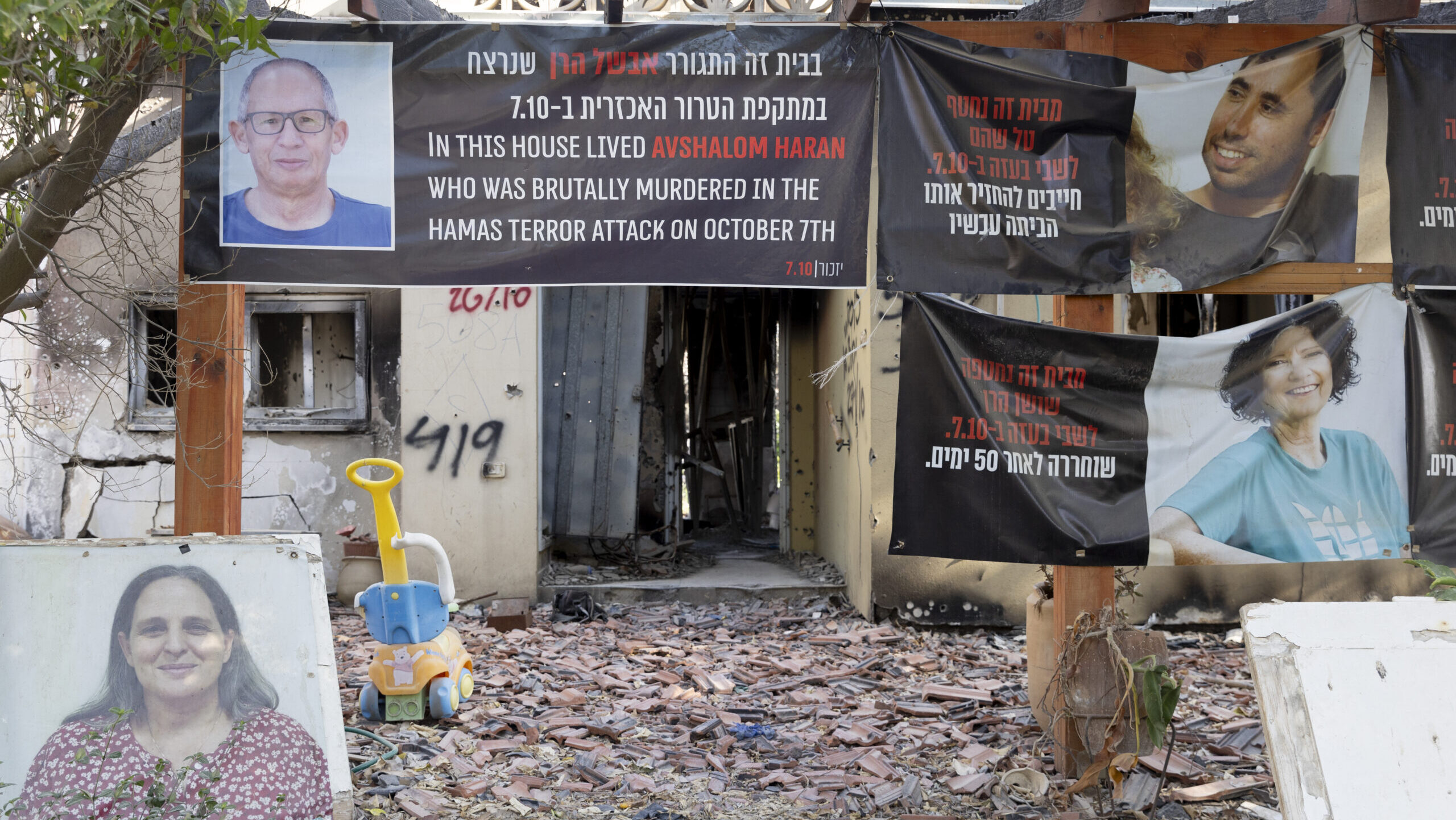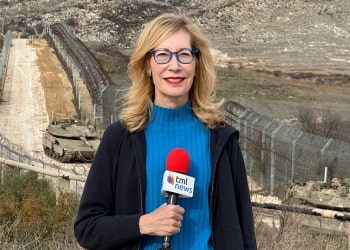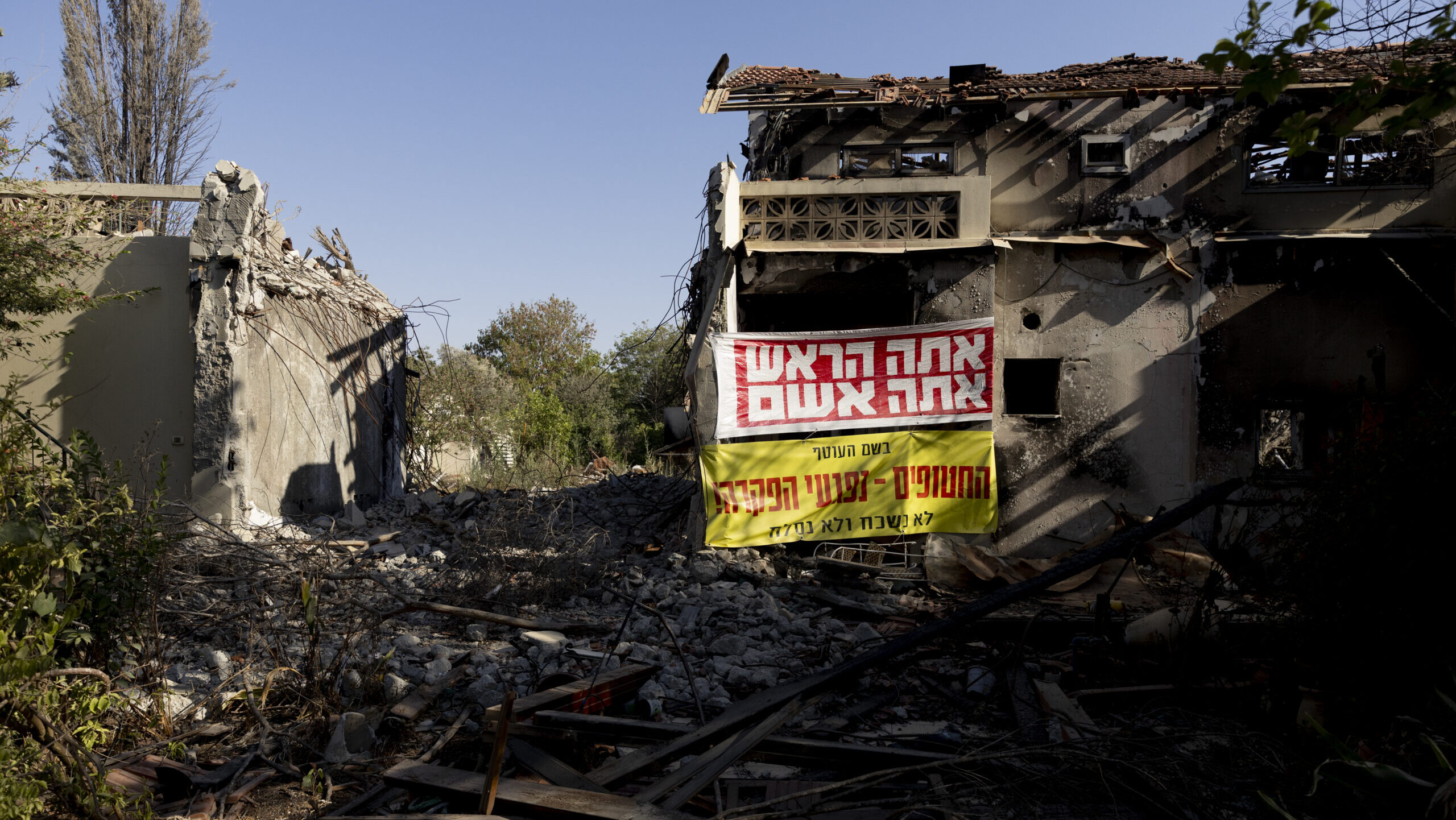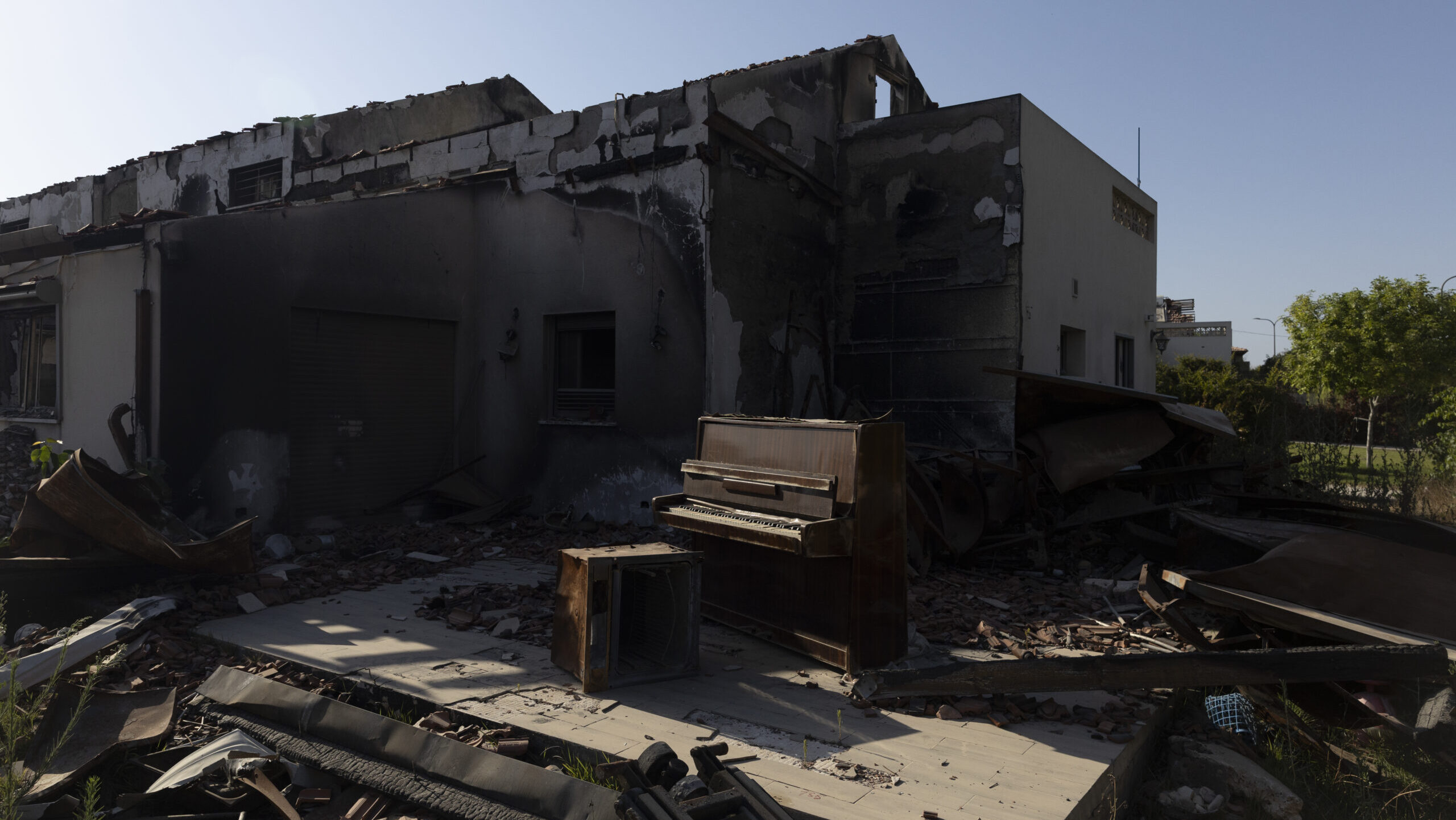Analysis: Probing the Be’eri Attack; Israelis Want More Answers
Experts analyze the failures and fallout of the Kibbutz Be’eri massacre investigation
Kibbutz Beeri, situated just three miles from Gaza, was once a picturesque community with neatly manicured lawns and charming homes. Today, it lies in ruins.
Houses are burnt, and their terra cotta roofs have collapsed. Bullet holes riddle the walls, telling the grim story of the lives lost within. Amidst the destruction, family portraits hang on still blood-stained walls, bearing silent witness to the tragedy. While the stench has now faded, in the days following the October 7 massacre, the air was thick with the suffocating odor of devastation.
Some 101 of the community’s roughly 1,000 residents lost their lives during the Hamas massacre. Twenty-nine people were kidnapped, 11 of whom are still in captivity. In addition, 31 security personnel died fighting the more than 300 terrorists who invaded Be’eri, including 23 IDF soldiers and eight police officers. Many others were injured–some severely. Israeli forces killed at least 100 terrorists in the kibbutz, and 18 were captured alive in a battle that, according to a new military investigative report, began at 6:30 a.m. on October 7 and only indeed ended two days later, on October 9.
Major General (Res.) Miki Edelstein conducted a military investigation that attempted to cover all aspects of the fighting in the kibbutz that day. He presented his findings last week—first to the resident survivors, most of whom are still displaced at hotels near the Dead Sea, and then to the greater public.
The information was gathered over three months and included hundreds of hours of conversations and interviews with kibbutz residents, members of the local security team, and other security personnel. According to the IDF, thousands of pieces of information and materials were gathered to create the most accurate and detailed account of the events.
The team, independent of the chain of command and not directly involved in the incidents, collected recordings from security communications systems, examined kibbutz member communications with consent, and conducted supplementary intelligence collection. They also utilized investigative materials from captured terrorists. The team gathered surveillance videos and observation documentation and conducted on-site reconstructions. The investigation was carried out in collaboration with the Shin Bet and the police, whose forces were also active in the kibbutz.
Israeli media extensively covered the release of the report on Thursday, which concluded that “the IDF failed in its mission to protect Israeli citizens” and was not prepared for the deadly Hamas attack, according to IDF Spokesperson Brigadier General Daniel Hagari.
But the report left some pressing questions unanswered: Was the report effective? Did it address the correct issues, reassure residents, and ensure the army learns the necessary lessons for improvement?
Moreover, will it bring about the political changes needed for Israel to move forward from the war in Gaza to the next phase?

Signs with photos of people who were kidnapped or killed hang on a house that was damaged during the deadly Oct. 7 Hamas attack on the kibbutz on June 24, 2024, in Be’eri, Israel. (Amir Levy/Getty Images)
As residents and the community digest the report’s findings, the consensus appears that while the report is critical, it falls short of achieving most, if not all, of these objectives.
The research is not done. The investigation is not over. There are still many holes.
“The research is not done,” Kibbutz Be’eri Chairman Amit Solvy told The Media Line. “The investigation is not over. There are still many holes.”
While he said the report “was important” and “made some order to what happened that day” for the residents who suffered the attack, he said he did not believe there was much there that they did not already know. “The report will not change anyone’s mind” about the IDF or whether or not they feel safe returning one day to Be’eri, he admitted. Instead, he told The Media Line, “It just showed us again the utter negligence” of the country’s security and political leaders and policies.
Experts expressed similar sentiments, stressing that the report sheds light on a specific event, but “focusing solely on one incident without considering the broader context can distort the overall understanding,” said Israeli intelligence and security expert Yossi Kuperwasser, who served as the head of the IDF’s research division. “The report leaves many questions unanswered,” he said, adding that a comprehensive understanding requires looking at the entire military operation in and outside Kibbutz Be’eri — before, during, and after the October 7 attack.
The investigation is no more than a technical investigation. It is a crystal clear and bleak picture of what happened there. But from the report, you cannot understand how it happened, what mistakes were made—nothing on the strategic level.
“The investigation is no more than a technical investigation,” stressed Col. (res.) Dr. Hanan Shai of the Misgav Institute for National Security and Zionist Strategy. “It is a crystal clear and bleak picture of what happened there. But from the report, you cannot understand how it happened, what mistakes were made—nothing on the strategic level.”
This holiday season, give to:
Truth and understanding
The Media Line's intrepid correspondents are in Israel, Gaza, Lebanon, Syria and Pakistan providing first-person reporting.
They all said they cover it.
We see it.
We report with just one agenda: the truth.


‘Failed to answer critical questions’
Solvy and other residents said the report did not provide Be’eri survivors with new information and failed to answer their pressing questions.
The kibbutz statement said that the IDF “failed to answer critical questions” in its investigation of October 7. Some of these questions include:
- Why did it take so long to move troops to the south in general and Be’eri in particular?
- Where was the Air Force?
- Why did numerous military forces gather at the gate of the kibbutz but not enter for many long hours while the kibbutz was burning and its residents were crying out for help?
- What caused the intelligence failure that allowed Hamas’s invasion plan?
- Why were there no early warning issues for the kibbutzim?
- How was the border fence breached without an immediate IDF response?
- Did the soldiers who arrived at the kibbutz understand that their primary goal was to protect civilians?
- What policies were in place, and why did they not work?
Everyone wants to know what happened. How did we end up in a situation far beyond what anyone imagined? This is not something you can expect to ask the people operating in Be’eri on October 7; they were not in charge.
“Everyone wants to know what happened,” Kuperwasser told The Media Line. “How did we end up in a situation far beyond what anyone imagined? This is not something you can expect to ask the people operating in Be’eri on October 7; they were not in charge.”
“Most of the people” who fought on October 7 “did their best and showed impressive courage and determination,” Kuperwasser continued. He said the report provides a timeline of what happened inside Be’eri from 6:30 a.m. until events concluded. However, he asked what was happening in the upper echelon during that same period.
“I don’t get the feeling that this was looked into,” Kuperwasser said.

A sign saying in Hebrew ‘you are the Prime you are guilty’ against Israeli Prime Minister Benjamin Netanyahu is hung on a house that was damaged during the deadly Oct 7 Hamas attack on the kibbutz on June 24, 2024, in Be’eri, Israel. (Amir Levy/Getty Images)
Be’eri residents: Report insufficient to restore trust
One purpose of the report was to help restore the military’s credibility and public trust. However, early reactions indicate this goal has yet to be fully achieved.
On Thursday, Kibbutz Be’eri issued a statement asserting that the investigation alone is insufficient to restore their trust in the army, calling for the establishment of a state commission of inquiry: The IDF “must provide us with answers that will allow us to begin to heal and draw practical conclusions for the future so that the unimaginable loss we experienced will never be experienced again by any other citizen; so that we can rebuild our trust in the security forces, and so that we can return to live in Be’eri with a sense of security,” the kibbutz said.
The report includes a focus on the shelling of Pesi Cohen’s house, where more than a dozen hostages were held, but only two survived. Brigadier General Barak Hiram approved a tank shell being fired at the house that day. The investigation revealed that the tank fire was likely not responsible for the hostages’ deaths and that the decision was made jointly by commanders from all relevant organizations, following proper protocols.
Following the incident, Brigadier General Hiram, a candidate for commanding the Gaza Division, faced criticism. The investigation does help clear his name, possibly removing obstacles to his appointment.
‘Leadership needs to draw appropriate conclusions’
Another criticism of the report is that it needs to provide the necessary information for the IDF to implement meaningful changes, according to Shai speaking to The Media Line.
One resident told Channel 13 that tempers reportedly flared during a presentation of the probe’s findings to Be’eri survivors, as IDF representatives did not address lessons to be learned.
Sharon Sharabi, whose brothers Eli and Yossi Sharabi were taken hostage, emphasized the need for leadership to draw appropriate conclusions in an interview with Channel 12.
“The IDF acted irresponsibly regarding Gaza border communities, and the leadership needs to draw the appropriate conclusions,” he said. “People were slaughtered in their homes. The top command should draw conclusions, and those who failed should resign.”
IDF Chief of the General Staff Herzi Halevi admitted in a statement that this first investigation did not reflect the entire picture and noted that additional investigations would provide a fuller picture of the onslaught and enable the IDF to draw operational conclusions that would be implemented immediately.
“This is an operational investigation,” spokesman Hagari said. “It contains facts, lessons, and conclusions. In the future, there will be things that will be examined, and there will also be personal conclusions.”
Hagari also clarified that the investigation did not cover the Air Force’s activities because a comprehensive review of the division’s efforts will be conducted separately and subsequently reported to the public.
Additionally, the IDF noted that it did not examine policies set by the political leadership to avoid conflict with government officials who insist that such investigations should be postponed until after the conclusion of the conflict with Hamas.
More reports to follow
The Be’eri investigation marks the beginning of what are expected to be numerous IDF probes into the events of October 7. The IDF said the Be’eri report’s release was prioritized due to the severity of the damage suffered by the kibbutz and because it was the first report ready for release.
There were approximately 40 battle sites during the Hamas attack, which are currently being investigated. Each investigation or set of investigations will be presented upon completion, with the IDF aiming to conclude all battle investigations by the end of the summer.
Simultaneously, Israeli media reported that the military is conducting an investigation spanning from the March 2018 Gaza border riots led by Hamas to October 10, 2023, when Israeli forces regained control of southern Israel after the attack. This inquiry includes IDF intelligence assessments on Hamas from 2018 onwards, as well as the military’s strategies for defense and operations against Gaza threats.
I have a lot of grievances about the IDF releasing Be’eri before others. They could have waited a couple more weeks and issued an entire report. There are all these dots you need to connect. First, connect the dots and see the big picture.
“I have a lot of grievances about the IDF releasing Be’eri before others,” Kuperwasser said. “They could have waited a couple more weeks and issued an entire report. There are all these dots you need to connect.
“First, connect the dots and see the big picture,” he continued. “Only then, look at the dots with a spotlight.”
Be’eri’s Solvy had a different concern. He asked, “How, from this research, can we return to our borders?”

